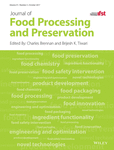Electrotechnologies, microwaves, and ultrasounds combined with binary mixtures of ethanol and water to extract steviol glycosides and antioxidant compounds from Stevia rebaudiana leaves
Funding information: F.P.U.; grant number: AP2010-2546; Spanish Ministry of Education (J.M. Carbonell-Capella); Marie Curie Intra-European Fellowship (Marie Curie IEF) (F.J. Barba); 7th European Community Framework Programme
Abstract
The aim of this work was to investigate the potential use of non-conventional technologies (microwaves, ultrasounds, pulsed electric fields, and high voltage electrical discharges) to enhance the extraction of high-added value compounds (mainly stevioside and rebaudioside A), and antioxidants (total phenolic compounds, flavonoids, chlorophylls, and carotenoids), from Stevia rebaudiana leaves. After treatment at equivalent energy, a supplementary diffusion was performed until 1 h. Results demonstrated that when water (100%) was used as solvent, the maximum recovery of stevioside (50.8 ± 0.1 mg/g) was obtained after ultrasound-assisted extraction, while microwave allowed the highest yields of rebaudioside A (22.7 ± 0.1 mg/g). However, pulsed electric field technology was the most efficient to recover stevioside (44.2 ± 0.1 mg/g) and rebaudioside A (22.4 ± 0.3 mg/g) when using 50% ethanol-water. Results obtained through this work pave the way toward the possible scaling-up of some of these non-conventional technologies for a multistep selective extraction of valuable compounds from Stevia leaves.
Practical applications
Recovering high added value compounds (i.e. stevioside and rebaudioside A) from stevia leaves in food industry is usually performed using thermal extraction under agitation after drying and grinding. Although efficient, this technique generates an extract not only rich in targeted compounds but also in impurities, which complicates the downstream processing steps. Selective extraction of stevioside and rebaudioside A using non-conventional extraction technologies (i.e. pulsed electric field, etc.) may allow reducing the processing steps (grinding, downstream purification, etc.), and thus an alternative to the conventional method. For this reason, investigating the impact of these technologies at laboratory scale to recover target molecules from stevia leaves is of paramount importance before scaling up the process.




